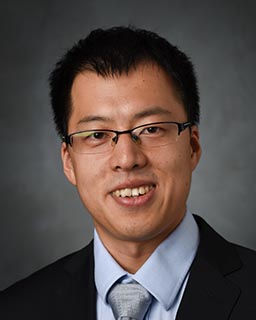A new course among early achievements for aerospace engineering faculty member
2/15/2021
By Mariah Chuprinski
UNIVERSITY PARK, Pa. — Since joining Penn State’s College of Engineering in August 2019, Daning Huang has made quick work of advancing his research and teaching mission as assistant professor of aerospace engineering.
Last spring, Huang developed and taught a graduate course on machine learning in aerospace engineering (AERSP 597), a first for the department.
“We exposed students to the latest advances in data-driven modeling studies and covered machine learning techniques for data-driven modeling and analysis that students could apply to their aerospace research,” Huang said.
Huang previously taught a math class for aerospace engineering undergraduates (AERSP 313). This semester, Huang is teaching a graduate course on aero- and hydro-elasticity (AERSP 505).
He also founded a research lab, Aerospace Multi-Physical and Unconventional Systems (APUS), which currently enlists the help of two doctoral students, two master’s students and two undergraduates.
“Our overarching goal at APUS is to tackle the problems arising from emerging aerospace systems, such as hypersonic vehicles and electric vertical take-off and landing aircraft,” he said, referring to high-speed aircraft that fly over five times faster than the speed of sound, and aircraft that operate vertically like helicopters but with novel multi-lift configurations. “These aircraft have been delayed in development because of their complex multi-physics nature and uncertain working environment.”
To do this, Huang and his team use a computational approach and leverage recent advances in data-driven techniques to enable multi-disciplinary analysis, design and optimization.
The group has been successful: In January alone, Huang’s team published six papers in the American Institute of Aeronautics and Astronautics SciTech 2021 Forum, five of which are being expanded into journal papers.
In one of the recent publications published in the journal Aerospace Research Central (ARC), Huang collaborated with Xiang Yang, assistant professor of mechanical engineering at Penn State, in a computational study on the interaction among the fluid, thermal and structural configurations in the control surface of a hypersonic vehicle.
In two others also published in ARC, Huang’s team explored systematic approaches to resolve the common two-model dilemma in engineering: where easy-to-compute models lack accuracy, while accurate models are computationally expensive or intractable.
“I am also involved in the Penn State Center for Acoustics and Vibration, and am in the process of starting a new technical group there, focusing on the application of artificial intelligence and machine learning to acoustics and vibration studies,” Huang said.
Huang holds a doctorate and a master’s degree in aerospace engineering from the University of Michigan, as well as a bachelor’s degree in aircraft design and engineering from the Nanjing University of Aeronautics and Astronautics in China.
He holds professional memberships in the American Institute of Aeronautics and Astronautics and the Vertical Flight Society. He was the recipient of the Rackham Predoctoral Fellowship in 2019 and Towner Prize for Distinguished Academic Achievement in 2018, both from the University of Michigan.




